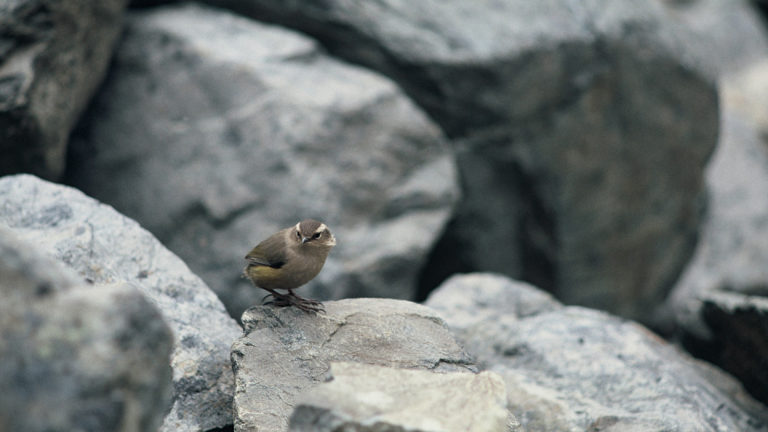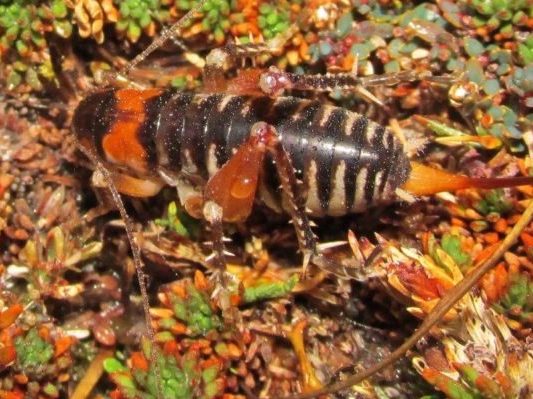It’s not easy counting weta on a steep mountainside in the middle of the night. One of Colin O’Donnell’s main research interests is alpine fauna – rock wrens, weta, other alpine invertebrates and hardy, rock-basking lizards who manage to survive above the bushline.

Weta are nocturnal, so after a day in the mountains collecting data on the other alpine species, the night hours will find Colin and his co-workers still on the mountain, counting weta along transect lines.
Colin O’Donnell is a Principal Science Advisor (Ecosystems and Species), based in the Department of Conservation’s Christchurch office. Not surprisingly, one of the things he is looking into, is finding easier ways to count weta numbers. He’s looking at using tracking tunnels, which have already been found to work well for lizards.

Then there are the rock wrens. These tiny birds are our only truly alpine bird species as, unlike kea, they never venture down from their mountain home. Their small size means that they lose heat faster than a larger bird would – so how does such a small bird survive in such a harsh environment?
Colin thinks they may be able to lower their body temperature to conserve energy – perhaps by something like 10 degrees. It’s a survival strategy that’s been found in a few bird species around the world. It’s not quite true hibernation – our native bat species can lower their body temperature to nearly zero and hibernate off and on, on a daily basis – but in a bird it is a rare and incredible survival technique. These little birds are tough!
The alpine cold is only one of the hazards facing our endangered rock wrens. In 2012, the first year of his alpine research, Colin and other members of the rock wren team monitored 20 nests.
“100% were preyed on,” Colin says. “Half the nests had cameras and all of those nests were preyed on by stoats. The cameras showed that the stoat would come during the day and have a look, then come back at night and get the mother bird incubating the chicks.”
Back in 2012, without predator control, rock wrens had around 15% nesting success.
“After trials of 1080 and trapping, there is an 85% success rate in monitored rock wren nests.”
About 13% of New Zealand is alpine habitat, but compared to forest ecosystems, the alpine regions have been little studied. In terms of our scientific research, Colin reckons alpine habitats are “where forests were in the 1980s.”
There’s a lot of work to be done – and some interesting stories to uncover. Those elusive alpine weta Colin was counting, for example, have a kind of ‘anti-freeze’ in their blood that means they can survive being frozen in a block of snow or ice.
There are about 30 different lizards living in the mountains too, some of them alpine specialists.
Often they’re quite localised in where they’re found and so tend to be named for where they live. The Sinbad Skink lives in Sinbad Gully near Mitre Peak – a remote gully which was also where the last mainland kakapo survived. The Barrier Skink is found only on top of Barrier Knob, about 20km to the northeast of Sinbad Gully. The Takitimu Gecko was thought to live only in the Takitimu mountains near Te Anau – until, to the surprise of herpetologists, one was found near sea-level at Waitutu.

Colin’s work doesn’t just involve looking at individual species and monitoring their survival. That’s only one part of putting the alpine ecosystem jigsaw together in order to see the picture as a whole.
For example, mice prey on rock wrens and probably weta, so Colin is monitoring mouse numbers. Do forest stoats invade the alpine zone at beech mast? Does the alpine zone have mast years of its own with a population explosion of predators? Part of Colin’s research involves monitoring seed-production in alpine plants, such as Celmisia (daisies), along with plants that produce berries and the various tussock species.
“It’s too soon to say if there’s an alpine mast,” Colin says, “but tussocks probably do mast and they probably do affect mice. Different species of tussock probably set seed at different times.”
By gaining a better understanding of all the factors that drive predator number, predator control can be targeted at the right times and in the right years where it can be most effective. It is already working in our forests – the Eglinton Valley and Landsborough Valley have also been longterm research projects for Colin and the recovery in kaka numbers in the Eglinton Valley is a great example of predator control working well.
“Before predator control, 80% of kaka nests were preyed on by stoats and adult females also killed. No females have been preyed on for years and now at least 80% of nests are successful. You used to see one kaka in a week in the valley,” Colin says, “Last year I saw a flock of 200 – you see them everywhere!”

